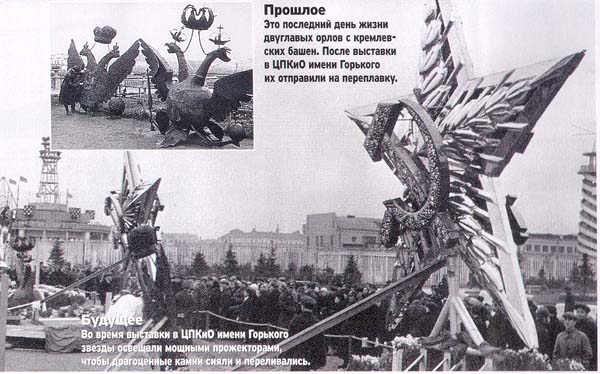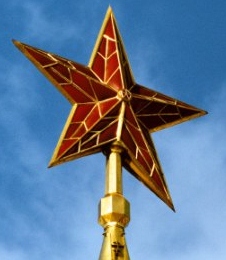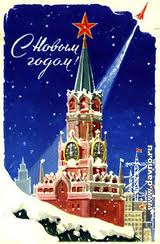By Eric Laursen (W&M Contributor)
In 1935 the tsarist eagles that once perched atop the five towers of the Moscow Kremlin were replaced with massive revolving silver stars cut out of metal, with the design of a hammer and sickle made from semi-precious stones mined in the Urals (around 7000 stones were used in total). The stars were built in the prop department of the Bolshoi theater, a fact that signals the theatricality of this act of dressing the stage of power. Before being installed, several of the new stars were displayed at ground level next to the metal tsarist eagles that had been removed to make way for them. A Pravda correspondent declared enthusiastically: “A striking spectacle! On one side–the brilliant embodiment of our finest contemporary technology, our astounding culture of labor, the high skill of our collective; on the other side–rusted iron birds, shoddily made, riveted crudely and primitively, like samovar pipes.” As in many of the images of Soviet enlightenment, the stars are presented as a marvel of the “finest contemporary technology“ and socialist labor, which hones “the high skill of our collective” to the point where they can produce craftsmanship that is far superior–both in aesthetics and in construction–to those made by workers exploited by the aristocracy. The tsarist “birds” were “shoddily made,” never meant to last and therefore rusted by the processes of time. The eagles are compared to samovars, a technology connected with the Russian countryside–not the progressive city–and powered for generations by burning coal, “crudely and primitively.” Compare these aging rusty eagles to the silver stars that revolved because of electricity and were illuminated at night by electric light. The silver and stone stars were presented as shining tributes to the Soviet ability to rework mother nature, to take semiprecious stones and metal from the ground and mold them into the stage props of a grand “spectacle,” massive pieces of costume jewelry designed exclusively for the Soviet staging of power.
The silver stars, “the brilliant embodiment of our finest contemporary technology” soon lost their luster due to Moscow pollution. The red glass and metal stars that are usually referred to as “ruby” stars took their place, minus the hammer and sickle, a deletion that Julia Bekman Chadaga sees as evoking the politics of 1937: “There was thus a shift in emphasis away from the human labor involved; now all eyes were on the light source that stood for ‘Soviet power,’ more specifically, the charismatic power of Stalin, the deity in the Kremlin.” It would be just as easy, however, to read the change as one from hand-craftsmanship–semi-precious stones mounted by Soviet artisans–to factory produced artifice, a mark of Soviet industrialism. In the ruby stars the rough elements produced by nature–sand and metal–had been transformed by Soviet industry into a substance that nature could not produce by itself. The ruby stars resist the weather and yet retain brilliance, by day from three sheets of layered glass–white and red with a clear sheet sandwiched in between to aid in reflectivity of sunlight–and by night from a system of mirrors and light bulbs installed in their base. Rather than needing external illumination, these stars echo the stars above them by producing their own light from within, and due to the layering of glass are able to shine both by day and by night.
These enormous stars—the largest of which is twelve feet across–were installed in September and October of 1937, just in time for the 20th anniversary of the revolution. The Kremlin Stars were attributed with the same powers always given to the red star–a force of good fighting the forces of darkness, but now connected to the 800-year history of the Kremlin, a seat of political power for pre-Petrine Russia and the Soviet Union (with Petersburg taking the stage for over two centuries in between). Therefore the mounting of the red stars on the ancient Kremlin constituted a reclaiming of Russia’s history for the Soviet Union. By having the stars powered by electricity the installation also became a symbol of the rejuvenation of this traditional power. A 1938 song by Vasilii Lebedev-Kumach depicts Moscow “bravely conquering all powers of darkness [sily mraka], lit up by the blaze of scarlet stars, eight centuries old but eternally young.”



